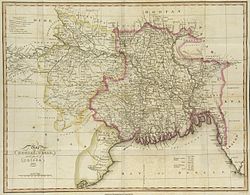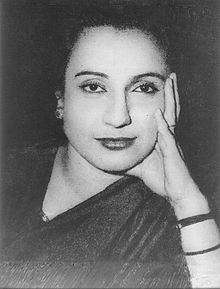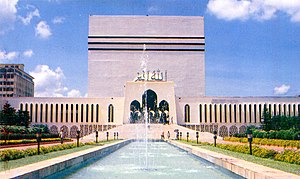East Bengal
| East Bengal | |||||||||
|---|---|---|---|---|---|---|---|---|---|
| Provinceof theDominion of Pakistan | |||||||||
| 1947–1955 | |||||||||
 Location of East Bengal (green) and the rest of Pakistan (light green) | |||||||||
| Capital | Dacca | ||||||||
| • Type | Provincial government | ||||||||
| Legislature | Legislative Assembly | ||||||||
| History | |||||||||
| 15 August 1947 | |||||||||
| 14 October 1955 | |||||||||
| |||||||||
| Today part of | |||||||||
| History ofBangladesh |
|---|
 |
|
|
 |
| This article is part of the series |
| Former administrative units of Pakistan |
|---|
East Bengal(/bɛnˈɡɔːl/;Bengali:পূর্ব বাংলা/পূর্ববঙ্গPurbô Bangla/Purbôbongo) was the eastern province of theDominion of Pakistan,which covered the territory of modern-dayBangladesh.It consisted of the eastern portion of theBengalregion, and existed from 1947 until 1955, when it was renamed asEast Pakistan.East Bengal had a coastline along theBay of Bengalto the south, and borderedIndiato the north, west, and east and shared a small border with Burma (presently known asMyanmar) to the southeast. It was situated near, but did not share a border withNepal,Tibet,theKingdom of Bhutanand theKingdom of Sikkim.Its capital was Dacca, now known asDhaka.
ThePartition of India,whichdivided Bengalalong religious lines, established the borders of the Muslim-majority area of East Bengal. The province existed during the reign of two monarchs,George VIandElizabeth II;and threegovernors-general,Muhammad Ali Jinnah,Khawaja NazimuddinandGhulam Muhammad.Its provincial governors included a British administrator and several Pakistani statesmen. Its chief ministership was held by leading Bengali politicians.
East Bengal was the most populous and cosmopolitan province in thedominion.It was a hub of political movements, including theBengali language movementand pro-democracy groups. It was dissolved in 1955 and replaced byEast Pakistanduring theOne Unit Schemeimplemented by Prime MinisterMohammad Ali of Bogra.
The provincial legislature was theEast Bengal Legislative Assembly.
History
[edit]
Mandates for partition
[edit]Between 1905 and 1911, a province calledEastern Bengal and Assamexisted in the region as part of theBritish Indian Empire.TheAll India Muslim Leaguewas founded in the British province in 1906.
The All India Muslim League adopted theLahore Resolutionin 1940, which envisaged the creation of sovereign states in the Muslim-majority areas of eastern and northwestern British India. The League won elections in Bengal in 1946, receiving its largest mandate in the province.
In May 1946,Rohingya Muslimleaders met withMuhammad Ali Jinnah,and asked for a formal annexation of theMayu region.Two months later, the North Arakan Muslim League also askedJinnahto annex the region.[1]Jinnah refused, saying he could not interfere with Burma's internal matters. Proposals were also made to theBurmese governmentbut they were rejected.[2]
TheDistrict of SylhetinAssam Provincealso voted to reunite with the rest of East Bengal, and the Muslim League's campaign played a great role in facilitating this. Aplebiscitewas held which resulted in joining Pakistan. However, a large part of Sylhet'sKarimganj subdivisionwas barred due toAbdul Matlib Mazumdar's delegation. TheChittagong Hill Tracts,which had a 97% non-Muslim population (mostlyBuddhist), was awarded toPakistan,by the Boundary Commission, due to it being inaccessible to India and to provide a substantial ruralbufferto supportChittagong,a major city and port; advocates for Pakistan forcefully argued to the Bengal Boundary Commission that the only approach was through Chittagong.
As a result of these mandates, theMountbatten PlanandRadcliffe Lineestablished East Bengal as a province of the newly formed Dominion of Pakistan in August 1947.
Nazimuddin ministry
[edit]
SirKhawaja Nazimuddin,a formerprime minister of Bengal,was the first chief minister of East Bengal after partition. Nazimuddin was a senior leader of the Muslim League and a close confidante of Pakistan's founderMuhammad Ali Jinnah.SirFrederick Chalmers Bournewas the first governor of East Bengal. Partition resulted in making many Hindus to leave East Bengal while Muslims from different parts of the Indian subcontinent migrated to East Bengal. The East–West Bengal border did not see as much violence as seen in the Punjab border between North India and Pakistan.
Jinnah made his sole visit to East Bengal as governor general in 1948. During a speech to students inDacca University,he resisted demands to makeBengalia federal language. His refusal sparked fierce protests among East Bengalis who comprised the majority of Pakistan's population. The proposal for Urdu as the sole national language met with strong opposition in East Bengal, where Urdu considered rather alien, especially in light in Bengali's rich literary heritage.
When Jinnah died in 1948, Nazimuddin became the governor general of Pakistan.
Amin ministry
[edit]
The conservative Muslim League leaderNurul Aminsucceeded Nazimuddin as chief minister. According to some sources, Amin had strained relations with the federal government, including Prime MinisterLiaquat Ali Khanand Governor General Khawaja Nazimuddin. Historians have noted that Amin's government was not strong enough to administer the provincial state; it was completely under the control of the central government of Nazimuddin. His government did not enjoy enough power and lacked vision, imagination, and initiatives.
In 1949,Maulana Bhashaniled left-wing elements in the Muslim League to break away and form theAwami Muslim League.The new party was joined byHuseyn Shaheed Suhrawardy,a former prime minister of British Bengal. The new party later dropped the word Muslim, fashioned itself as secular and courted votes from East Bengal's large non-Muslim minorities.
Thelanguage movementreached a climax in 1952. During the unrest, the police shot dead four student activists. This raised more opposition in the region to the Muslim League.[3]Leading politicians in West and East Pakistan called for Amin's resignation. In subsequent provincial elections, Amin lost his seat in the legislative assembly.
Huq ministry
[edit]
In the 1954, theUnited Frontcoalition resoundingly defeated the Muslim League with a landslide majority. The coalition included the Awami League, theKrishak Praja Party,the Democracy Party and Nizam-e-Islam. The esteemed lawyerA. K. Fazlul Huq,popularly known as the Sher-e-Bangla (Lion of Bengal), became chief minister. Huq established theBangla Academyand called for greater provincial autonomy. He wanted the federal government's responsibilities limited to only foreign affairs and defense.
King Saudof Saudi Arabia sent a plane to bring Huq to a meeting with the monarch.[4]The New York Timespublished an article claiming Huq wanted independence for East Bengal. While visiting Calcutta and New Delhi, Huq was received by Indian leaders. Barely a few months into office, Huq was dismissed by Governor General Ghulam Muhammad due to allegations against of Huq of inciting secession.
Sarkar ministry
[edit]AfterGovernor General's rulewas withdrawn in 1954,Abu Hussain Sarkarbriefly served as chief minister, before Governor General's rule was again imposed.[5]He started the construction ofCentral Shaheed Minar.
Khan ministry
[edit]Governor General's rule was withdrawn in June 1955.Ataur Rahman Khanof the Krishak Sramik Party was the last chief minister. His government declared 21 February, the anniversary of the language movement, a public holiday. He later resigned on 30 August 1956 over inflation of food grains and subsequent food shortages.[6]
One Unit
[edit]As part of the reforms and reorganization policies ofPrime Minister of PakistanMohammad Ali of Bogra,East Bengal was renamed asEast Pakistanon 14 October 1955.
Federal law and East Bengal
[edit]

East Bengal existed when Pakistan did not have a written constitution. Instead, the Pakistani courts relied onEnglish common lawand theObjectives Resolution.
Constitutional coup
[edit]In 1953, Prime Minister Khawaja Nazimuddin's government was dismissed by Governor General Ghulam Muhammad, in spite of enjoying the confidence of a majority in theConstituent Assembly of Pakistan.The governor general later dissolved the constituent assembly itself. In the case ofFederation of Pakistan v.Maulvi Tamizuddin Khan,the speaker of the dissolved constituent assembly challenged the governor general's decision in the Sindh High Court. The case proceeded to the apex court- the Federal Court of Pakistan- where Justice M. Munir ruled in favour of the governor general. JusticeA. R. Corneliusexpressed dissent and supported Speaker Khan. The dismissal of the prime minister and assembly was one of the first major blows to democracy and the rule of law in the Pakistani Union.
Reform demands
[edit]BegumShaista Suhrawardy Ikramullahcalled for Pakistan's constituent assembly to convene in Dacca as East Bengal was home to the majority of Pakistan's population.[7]
Governors and chief ministers
[edit]| Tenure | Governor of East Bengal[8] |
|---|---|
| 15 August 1947 – 31 March 1950 | Sir Frederick Chalmers Bourne |
| 31 March 1950 – 31 March 1953 | Sir Feroz Khan Noon |
| 31 March 1953 – 29 May 1954 | Chaudhry Khaliquzzaman |
| 29 May 1954 – May 1955 | Iskandar Ali Mirza |
| May 1955 – June 1955 | Muhammad Shahabuddin(acting) |
| June 1955 – 14 October 1955 | Amiruddin Ahmad |
| 14 October 1955 | Province of East Bengal dissolved |
| Tenure | Chief Minister of East Bengal[8] | Political Party |
|---|---|---|
| 15 August 1947 – 14 September 1948 | Sir Khawaja Nazimuddin | Muslim League |
| 14 September 1948 – 3 April 1954 | Nurul Amin | Muslim League |
| 3 April 1954 – 29 May 1954 | A. K. Fazlul Huq | United Front |
| 29 May 1954 – August 1955 | Governor's Rule | |
| 20 June 1955 – 14 October 1955 | Abu Hussain Sarkar | Krishak Sramik Party |
| 14 October 1955 | Province of East Bengal dissolved |
Economy, culture, religion and military
[edit]
Orient Airways,owned by an East Bengal-based industrialist, launched the first flights betweenKarachiandDacca.The airline later evolved intoPakistan International Airlines.
TheChittagong Tea Auctionwas established in 1949.
As a result of the Bengali language movement, East Bengal was a center of Bengali cultural activities.
The University of Dacca was hotbed of political thought.
TheEast Bengal Regimentwas formed on 15 February 1948 following Pakistan's independence and transition from post British rule. The infantry of the newPakistan Armywas made up exclusively of men from the western part of the country. It was consequently necessary to raise a regiment in the east. A total of eight battalions were raised. Paramilitary forceslike theEast Pakistan RiflesandEast Pakistan Ansarswere established, Ansars were deployed to the border areas in 1948 during theIndo-Pakistani war of 1947–1948to prevent crimes and smuggling.[9]
Religion
[edit]East Bengal (present-day-Bangladesh) had a population of 19 million people in the year 1800 A.D,[12]of which 10.716 million people were followers ofHinduismrepresenting a majority of about 56.4% of the region's population,[13]while 7.961 million adheres to theMuslimfaith, constituting 41.9% of the region's population as 2nd largest community.[14]The smaller number of 323,000 people followedBuddhism,AnimismandChristianity,together presenting around 1.7% of the region's population.

Bangladesh's capitalDhakacity name is said to have been derived fromDhakeshwarithe patron goddess of the city, whose shrine is located inRamnaof Dhaka city.[15]In Bangladesh, there's exist a blending culture of Hindu, Muslim, Buddhist, folk religion, deities and practices. Worship exchanges takes place at temples and mosques and religious folk music gatherings (especially at Vaishnavite gatherings and among Muslim Sufis). Folk deities recognized by both Hindus and Muslim have includedShitala,the goddess of small pox,Oladevi,goddess of cholera,Manasa,goddess of snakes and are worshipped by Hindus and Muslims of Bangladesh both alike.[16]
Present
[edit]
Religion in Bangladesh (2022 census)[17]
As of 21st century, the present region of East Bengal exists in form of sovereignBangladeshtoday and is now an Islamic country both demographically and constitutionally as the country holdsfourth-largest Muslim populationin the globe andIslamis the officialstate religionofBangladeshby Article (2A).[18]Thepopulation of Bangladesh is 165.2 millionas per 2022 census report, of which majority of 150.49 million people (91.1 percent ofBangladeshis) followIslam,Hinduismis followed by 13.05 million people (7.9 percent of population) as second-largest religion,Buddhismbeing third-most followed religion and is followed by 991,000 people (0.6 percent of population),Christianityis followed by 495,000 people (0.3 percent of the population) and tiny micro-scopic minority of 165,000 people (0.1 percent of population) follow other religions most beingtribalandAnimists.[19]
See also
[edit]Notes
[edit]- ^See territorial exchanges between India and Bangladesh (India–Bangladesh enclaves).
References
[edit]- ^Thit Maung, Yebaw (1989).Civil Insurgency in Burma.Yangon: Ministry of Information. p. 30.
- ^Hugh Tinker,The Union of Burma: A Study of the First Year of Independence,(London, New York, and Toronto: Oxford University Press) 1957, p. 357.
- ^Mahmood, Safdar (1997).Pakistan: Rule of Muslim League and Inception of Democracy (1947-54).Lahore: Jang Publications. p. 116.OCLC39399433.
Agitation started in 1952 as a reaction against Nazimiid-Din's announcement in Dacca that only Urdu would be the national language. Police opened fire on the demonstrating students, killing four of them. The incident left deep scars on the body politic... and sealed the fate of the Muslim League in East Pakistan.
- ^CHRONOLOGY January 1, 1954 – December 31, 1954 Pakistan Horizon Vol. 7, No. 4 (December, 1954), pp. 238-246
- ^"Sarkar, Abu Hossain".Banglapedia.Archivedfrom the original on 2017-07-18.Retrieved2017-07-20.
- ^Sengupta, Nitish K. (2011).Land of Two Rivers: A History of Bengal from the Mahabharata to Mujib.Penguin Books India. p. 516.ISBN978-0-14-341678-4.
- ^"International relations, Foreign Affairs & policy, Benazir Bhutto - PIIA".Archivedfrom the original on 2018-11-18.Retrieved2017-07-02.
- ^ab'Statesmen of Bangladesh'Archived2012-03-04 at theWayback MachineRetrieved 18 April 2009.
- ^"Ansar and Village Defence Party".Banglapedia.3 September 2021.
- ^"A Bleak Future for Bangladesh Hindu's".February 2000.Archivedfrom the original on 2022-12-31.Retrieved2022-12-31.
- ^"Population of Bangladesh 1800-2020".Archivedfrom the original on 2022-12-31.Retrieved2022-12-31.
- ^"Population of Bangladesh 1800-2020".Archivedfrom the original on 2022-12-31.Retrieved2022-12-31.
- ^"A Bleak Future for Bangladesh Hindu's".February 2000.Archivedfrom the original on 2022-12-31.Retrieved2022-12-31.
- ^Raghunathan, V."Truth, half-truth and statistics".The Times of India.Archivedfrom the original on 2021-05-07.Retrieved2021-05-07.
- ^"Dhaka".Encyclopedia Britannica.Archivedfrom the original on 2017-10-10.Retrieved2023-01-02.
- ^"RELIGION IN BANGLADESH AND HINDUS, CHRISTIANS AND BUDDHISTS THERE | Facts and Details".Archivedfrom the original on 2023-01-02.Retrieved2023-01-02.
- ^"Census 2022: Bangladesh population now 165 million".Dhaka Tribune.27 July 2022.Archivedfrom the original on 27 July 2022.Retrieved5 January2023.
- ^"The Constitution of the People's Republic of Bangladesh | 2A. The state religion".Archivedfrom the original on 2021-01-17.Retrieved2023-01-02.
- ^"Census 2022: Bangladesh population now 165 million".Dhaka Tribune.27 July 2022.Archivedfrom the original on 27 July 2022.Retrieved5 January2023.



